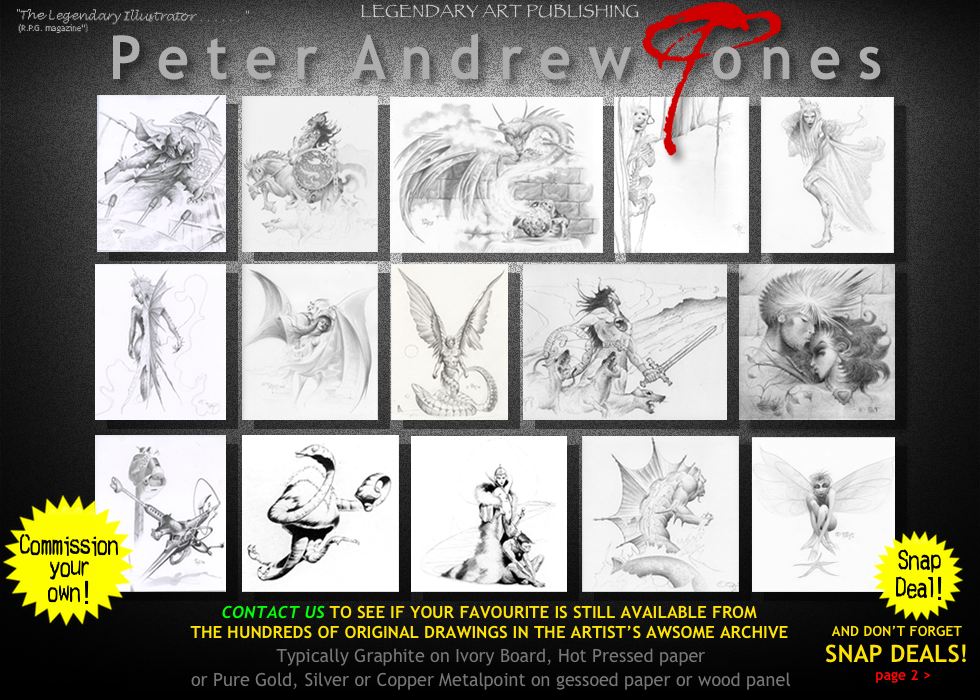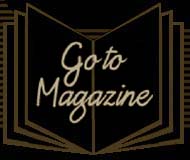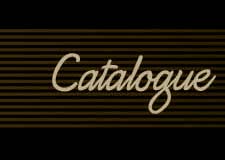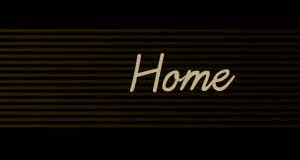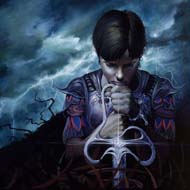|
|
About "prelims", "visuals" & "roughs" . . . . . .
 My "prelims" (preliminary) are usually highly finished works - not "sketchy". My "prelims" (preliminary) are usually highly finished works - not "sketchy".
 As
some fans and collectors of my works already know, my relationship with
"prelims" (or "roughs" as we called them in the paperback industry of
the 1970s in the UK, or "visuals" later in the 1980s in my time in TV
and
movies) is unusual simply because I rarely did any "sketches"
from about the mid
1970s onwards. As
some fans and collectors of my works already know, my relationship with
"prelims" (or "roughs" as we called them in the paperback industry of
the 1970s in the UK, or "visuals" later in the 1980s in my time in TV
and
movies) is unusual simply because I rarely did any "sketches"
from about the mid
1970s onwards.
 The
demand for my work from publishers grew extremely quickly in the early
few years of my career and was so intense that it was simply impossible to keep up
with it if time was spent on "prelims", so publishers, who vied with each other for my studio time, gave up asking for
them and instead just trusted that I would produce "final art" (the paintings) that "sold the
book". The
demand for my work from publishers grew extremely quickly in the early
few years of my career and was so intense that it was simply impossible to keep up
with it if time was spent on "prelims", so publishers, who vied with each other for my studio time, gave up asking for
them and instead just trusted that I would produce "final art" (the paintings) that "sold the
book".
 As
far as my memory serves me, by around 1976 (just three years after I'd
produced my very first book cover, for Puffin Books in the UK) my sales
reputation evolved to a point where W.H. Smith then the biggest
retailer of books in the UK, told one publisher they would "take
any book that has a PAJ cover on it without first seeing it" which was
a delight to the publisher's sales people out on the road as they didn't have to
bother hawking my cover proofs around and spending precious time
offering them to individual bookshop owners and managers and a delight
to me as I could spend more time on the finished painting and, if I got
myself organised, actually spend time on related personal pieces,
additional pieces, and often multiple variant pieces to explore the
idea(s) I wanted to convey, then choosing one of the variants to deliver to the publisher as a "final" piece. As
far as my memory serves me, by around 1976 (just three years after I'd
produced my very first book cover, for Puffin Books in the UK) my sales
reputation evolved to a point where W.H. Smith then the biggest
retailer of books in the UK, told one publisher they would "take
any book that has a PAJ cover on it without first seeing it" which was
a delight to the publisher's sales people out on the road as they didn't have to
bother hawking my cover proofs around and spending precious time
offering them to individual bookshop owners and managers and a delight
to me as I could spend more time on the finished painting and, if I got
myself organised, actually spend time on related personal pieces,
additional pieces, and often multiple variant pieces to explore the
idea(s) I wanted to convey, then choosing one of the variants to deliver to the publisher as a "final" piece.
 It
may also surprise some people that quite frequently I was not given a
book to read, or even a decent chapter of a book to base ideas on,
instead, often relying on either a one paragraph description from an
editor or even a verbal brief or indeed, believe it or not, no information at all. It
may also surprise some people that quite frequently I was not given a
book to read, or even a decent chapter of a book to base ideas on,
instead, often relying on either a one paragraph description from an
editor or even a verbal brief or indeed, believe it or not, no information at all.
 I did have a secret weapon though! I did have a secret weapon though!
 My
early works were produced while I was still at St. Martins School of
Art in central London (now Central St.Martins) and around the block, in
Soho, was "Dark They Were and Golden Eyed" the specialist Science
Fiction book shop named after the Ray Bradbury short story, and as often as I
could I used to go there and buy the imported American editions (usually first
to be produced in paperback) and read the book I was creating the UK
cover for. It worked quite well as a process for a time. My
early works were produced while I was still at St. Martins School of
Art in central London (now Central St.Martins) and around the block, in
Soho, was "Dark They Were and Golden Eyed" the specialist Science
Fiction book shop named after the Ray Bradbury short story, and as often as I
could I used to go there and buy the imported American editions (usually first
to be produced in paperback) and read the book I was creating the UK
cover for. It worked quite well as a process for a time.
 I
even created pictures for books I was unlikely to ever get asked to
cover. I remember making images relating to Michael Moorcock's
character Elric, Published in the UK by Pan Books, just because I liked
the concept even though the books were already published in the UK so I
would be unlikely to be asked to re-cover the series because it was
already so successful but at the time, in 1979, I was in negotiation
with David Larkin, the art director at Pan Books in the UK who
represented Ian Ballantine's company in The USA that had published the
Frazetta book and they were looking for "a significant follow-up" with
an anthology of my works, and I had this great but utterly crazy idea
that I could paint "all the covers I had not been asked to do for
paperbacks and put them in the anthology". To quote David Larkin, "when
are you ever going to have time to do that?" meaning he needed to get
on and get the book published and not hang around waiting to accomodate
PAJ's crazy desire. I
even created pictures for books I was unlikely to ever get asked to
cover. I remember making images relating to Michael Moorcock's
character Elric, Published in the UK by Pan Books, just because I liked
the concept even though the books were already published in the UK so I
would be unlikely to be asked to re-cover the series because it was
already so successful but at the time, in 1979, I was in negotiation
with David Larkin, the art director at Pan Books in the UK who
represented Ian Ballantine's company in The USA that had published the
Frazetta book and they were looking for "a significant follow-up" with
an anthology of my works, and I had this great but utterly crazy idea
that I could paint "all the covers I had not been asked to do for
paperbacks and put them in the anthology". To quote David Larkin, "when
are you ever going to have time to do that?" meaning he needed to get
on and get the book published and not hang around waiting to accomodate
PAJ's crazy desire.
 I guess I was quite obsessed really, thinking back on it now. I guess I was quite obsessed really, thinking back on it now.
 When I reflect on the sheer levels of energy that drove me then it is scary! When I reflect on the sheer levels of energy that drove me then it is scary!
 This
meant that my relationship with drawings and paintings was, and still
is, pretty much an individual one with the specific work and not a
procedural one where a "prelim" precedes the "finished painting", the
typical industry process of the era and relationship of one to-the other: Instead, I just
“plunged right in” with no “prelim” most of the time. This
meant that my relationship with drawings and paintings was, and still
is, pretty much an individual one with the specific work and not a
procedural one where a "prelim" precedes the "finished painting", the
typical industry process of the era and relationship of one to-the other: Instead, I just
“plunged right in” with no “prelim” most of the time.
 As
the 1970s moved on, and the market expanded, with my works increasingly
published throughout Western Europe, the fact publishers were
publishing non-English language editions made it even harder to deal
with the lack of written source material. In many cases, publisher's
requests were merely "let us have something" and it became increasingly
hard to even pin down exactly what they were going to actually use the
image(s) on! As
the 1970s moved on, and the market expanded, with my works increasingly
published throughout Western Europe, the fact publishers were
publishing non-English language editions made it even harder to deal
with the lack of written source material. In many cases, publisher's
requests were merely "let us have something" and it became increasingly
hard to even pin down exactly what they were going to actually use the
image(s) on!
 Eventually,
the commercial success of my work led to a situation where often I was
asked to create an image and the author wrote a passage around the picture or an editor would "amend" a novel to
accommodate the subject matter of my picture! Eventually,
the commercial success of my work led to a situation where often I was
asked to create an image and the author wrote a passage around the picture or an editor would "amend" a novel to
accommodate the subject matter of my picture!
 Essentially, the paintings often became the lead item with the book attached. Essentially, the paintings often became the lead item with the book attached.
"THE ULTIMATE SPELL"
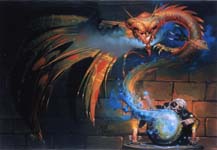 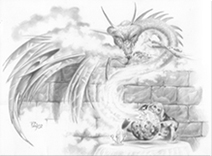 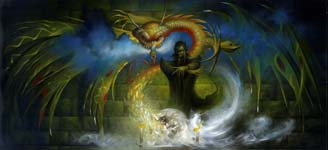 "Final" art + "Prelim drawing" & "prelim painting"
"Final" art + "Prelim drawing" & "prelim painting"
(and there's more in the archive!)
 Perhaps
the most striking, though by no means unique, example of how things frequently
occurred is illustrated by the creation process of the cover for the
Fighting Fantasy role play paperback book The Warlock of Firetop
Mountain (which is actually titled "The Ultimate Spell"). Perhaps
the most striking, though by no means unique, example of how things frequently
occurred is illustrated by the creation process of the cover for the
Fighting Fantasy role play paperback book The Warlock of Firetop
Mountain (which is actually titled "The Ultimate Spell").
 In
1982 when the art editor at Puffin, Doreen Scott, who I had known for many years,
called me in to discuss the cover for the book, I was told "it's a new
kind of book and we've no idea what to do with it"; they had already
had a cover done by somebody, I don't know who, which "was not working"
and I was asked to > In
1982 when the art editor at Puffin, Doreen Scott, who I had known for many years,
called me in to discuss the cover for the book, I was told "it's a new
kind of book and we've no idea what to do with it"; they had already
had a cover done by somebody, I don't know who, which "was not working"
and I was asked to >
"go away
and come back
with something
revolutionary"
 The deadline was an impossible one, eaten into by the previous "not suitable" cover art and artist. The deadline was an impossible one, eaten into by the previous "not suitable" cover art and artist.
 However,
as a favour to Doreen Scott years earlier, because she'd given me my very first book cover
job while I was still an art student, that even though I had
moved on to much more lucrative work years earlier in adult books, TV and movies and no
longer worked in children's books which paid badly in comparison, I'd
promised her in return for her help getting me started in the
profession when I was just 20 years old that she could "call me any
time you need something done and I will hapilly do
it for you." However,
as a favour to Doreen Scott years earlier, because she'd given me my very first book cover
job while I was still an art student, that even though I had
moved on to much more lucrative work years earlier in adult books, TV and movies and no
longer worked in children's books which paid badly in comparison, I'd
promised her in return for her help getting me started in the
profession when I was just 20 years old that she could "call me any
time you need something done and I will hapilly do
it for you."
 It was a favour to her, and nothing else, as far as I was concerned. It was a favour to her, and nothing else, as far as I was concerned.
 As
far as I recall I was given no manuscript, editorial overview, synopsis
of any meaningful kind or input for such an important new book series launch.
The "briefing" lasted "minutes". To
get around this problem plus the problem that there was simply no
sufficient time allowed by the severely shortened deadline > As
far as I recall I was given no manuscript, editorial overview, synopsis
of any meaningful kind or input for such an important new book series launch.
The "briefing" lasted "minutes". To
get around this problem plus the problem that there was simply no
sufficient time allowed by the severely shortened deadline >
 I
took an existing personal painting from "stock", did a bit more work to
it, stuck a label on the back as I always did when I delivered a piece
to a client, and let her publish it. In
short , my painting, which I'd entitled "The Ultimate Spell" was nothing to do with the Fighting
Fantasy book series, it was merely a stock sale from what
eventually grew to be THE SOLAR WIND PICTURE LIBRARY, one of hundreds
my licensing agency carried out in virtually every country on the planet
for a quarter of a century until I closed the agency in the late 1990s
and turned to self-publishing, a decision based on the sheer extent of
subscribers to my internet fan mailing lists, which made it abundantly
clear I did not need (and therefore no longer wanted) anyone else to
publish my works. I
took an existing personal painting from "stock", did a bit more work to
it, stuck a label on the back as I always did when I delivered a piece
to a client, and let her publish it. In
short , my painting, which I'd entitled "The Ultimate Spell" was nothing to do with the Fighting
Fantasy book series, it was merely a stock sale from what
eventually grew to be THE SOLAR WIND PICTURE LIBRARY, one of hundreds
my licensing agency carried out in virtually every country on the planet
for a quarter of a century until I closed the agency in the late 1990s
and turned to self-publishing, a decision based on the sheer extent of
subscribers to my internet fan mailing lists, which made it abundantly
clear I did not need (and therefore no longer wanted) anyone else to
publish my works.
 It
is, in fact, one of several versions of the picture I'd generated for
my own personal pleasure, which was a habit of mine that began even
when I first started as a professional artist, in fact, it was probably
a habit triggered on that very first day I took my portfolio to that
very first
Puffin Books client meeting with Doreen Scot (bless you Doreen) in the
summer of 1973, because on the day she asked me to "do a
sample for me" (which eventually led to my first actual commission in
that summer of 1973)
and so I had a "spare picture" even from day one. It
is, in fact, one of several versions of the picture I'd generated for
my own personal pleasure, which was a habit of mine that began even
when I first started as a professional artist, in fact, it was probably
a habit triggered on that very first day I took my portfolio to that
very first
Puffin Books client meeting with Doreen Scot (bless you Doreen) in the
summer of 1973, because on the day she asked me to "do a
sample for me" (which eventually led to my first actual commission in
that summer of 1973)
and so I had a "spare picture" even from day one.
 On
the day I took that very first "sample" piece to show her, in a way, a
"prelim" to actual commissioned work she would subsequently give me,
she took one look at it and simply said - "fine". On
the day I took that very first "sample" piece to show her, in a way, a
"prelim" to actual commissioned work she would subsequently give me,
she took one look at it and simply said - "fine".
 I had expected to have to justify my picture-making decisions ------- I had expected to have to justify my picture-making decisions -------
 That
very first "sample" fantasy painting of mine (below) created in the summer of
1973 while still at St. Martins School of Art, still hangs on my studio wall to this very day. That
very first "sample" fantasy painting of mine (below) created in the summer of
1973 while still at St. Martins School of Art, still hangs on my studio wall to this very day.
 One
of the advantages of being young and new to something is that you don't
know how things work, so I just kept on making variants of pictures a
lot of the time, mainly to explore different types of materials,
exploring the differences of pencil, oil paint, acrylic, gouche, paper,
card, hardboard, canvas (even glass!) when I had time, such as this
drawing and "spare" painting that I did at the same time as creating the "final art" for The
Zap Gun, created for Panther Books in 1974 > One
of the advantages of being young and new to something is that you don't
know how things work, so I just kept on making variants of pictures a
lot of the time, mainly to explore different types of materials,
exploring the differences of pencil, oil paint, acrylic, gouche, paper,
card, hardboard, canvas (even glass!) when I had time, such as this
drawing and "spare" painting that I did at the same time as creating the "final art" for The
Zap Gun, created for Panther Books in 1974 >
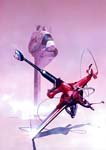 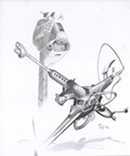 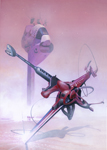 "Final" art + "Prelim drawing" & "prelim painting"
"Final" art + "Prelim drawing" & "prelim painting"
 So,
a decade later, I had amassed a "library" of "spare" art and when
confronted with impossible deadlines I could pull a picture "from
stock" usually at the publisher's request, and so the million-selling
Warlock of Firetop Mountain cover
was, in fact, a "spare" picture and merely a simple favour granted to
someone I liked working with for whom I had created my first ever cover
for a decade earlier. So,
a decade later, I had amassed a "library" of "spare" art and when
confronted with impossible deadlines I could pull a picture "from
stock" usually at the publisher's request, and so the million-selling
Warlock of Firetop Mountain cover
was, in fact, a "spare" picture and merely a simple favour granted to
someone I liked working with for whom I had created my first ever cover
for a decade earlier.
 While
the success of Fighting Fantasy was spreading worldwide, requests
from publishers around the world, as far apart a Brazil and Tokyo who
were publishing almost any kind of role play publications, books,
boardgames, even phone cards, put my studio under further pressure and
time constraints and when the French publisher Editions Gallimard
had excellent sales from my Lone Wolf covers created for them, which
also was published in Italy by Editioni E. Elle, the UK publisher of
the series began buying the French cover art for the Lone Wolf
series from me which evolved into creating additional pictures for them in the UK
and before long, with the fall of the Berlin Wall in 1990, Eastern
European start-up publishers in countries such as Hungary, The Czech
Republic, Poland and even on the border with China, created a situation
where even creating drawings in parallel with the paintings became
difficult and soon I found myself even creating drawings while on a
flight to Hollywood to work on a movie poster and creating one in the
wardroom of HMS Nottingham, a British warship, while a guest of the
Royal Navy for an aviation art project In was working on. While
the success of Fighting Fantasy was spreading worldwide, requests
from publishers around the world, as far apart a Brazil and Tokyo who
were publishing almost any kind of role play publications, books,
boardgames, even phone cards, put my studio under further pressure and
time constraints and when the French publisher Editions Gallimard
had excellent sales from my Lone Wolf covers created for them, which
also was published in Italy by Editioni E. Elle, the UK publisher of
the series began buying the French cover art for the Lone Wolf
series from me which evolved into creating additional pictures for them in the UK
and before long, with the fall of the Berlin Wall in 1990, Eastern
European start-up publishers in countries such as Hungary, The Czech
Republic, Poland and even on the border with China, created a situation
where even creating drawings in parallel with the paintings became
difficult and soon I found myself even creating drawings while on a
flight to Hollywood to work on a movie poster and creating one in the
wardroom of HMS Nottingham, a British warship, while a guest of the
Royal Navy for an aviation art project In was working on.
 Eventually,
by the time I created the Kult works for Target Games during the 1990s
in Sweden and most particularly their Trading Cards where the number of
works to be created was extensive, the situation became impossible and
even my long standing tradition of "creating drawings and additional
paintings" while working on the main image to be delivered to the
client could not keep up with the market demand, indeed, even the task
of creating the specific main individual artwork to be delivered to the
client became an impossible situation where demand for the work had
completely outstripped the ability to create enough of it to satisfy
the market, the work now appearing in almost every single market in the
world except Russia and China and the Middle East (though it did get
published in Israel) and this created a "fork in the road" situation,
where something had to be done to deal with it. Eventually,
by the time I created the Kult works for Target Games during the 1990s
in Sweden and most particularly their Trading Cards where the number of
works to be created was extensive, the situation became impossible and
even my long standing tradition of "creating drawings and additional
paintings" while working on the main image to be delivered to the
client could not keep up with the market demand, indeed, even the task
of creating the specific main individual artwork to be delivered to the
client became an impossible situation where demand for the work had
completely outstripped the ability to create enough of it to satisfy
the market, the work now appearing in almost every single market in the
world except Russia and China and the Middle East (though it did get
published in Israel) and this created a "fork in the road" situation,
where something had to be done to deal with it.
 The
solution was presented by the advent of technology, both the web and
affordable desktop publishing, and to preserve my desire to create in
an unrestricted way and not be blocked from doing so, I ceased
providing works for "other publishers" and in 1999 closed the licensing
division of my company, ceased creating work for "other publishers" and
began self-publishing which allows me to create in a
completely unrestricted way and so it is that my long held policy
of creating several related works on a theme evolved into illustrating
my own books, which ensures no restrictions occur and, more excitingly, every work now gets published - by me. The
solution was presented by the advent of technology, both the web and
affordable desktop publishing, and to preserve my desire to create in
an unrestricted way and not be blocked from doing so, I ceased
providing works for "other publishers" and in 1999 closed the licensing
division of my company, ceased creating work for "other publishers" and
began self-publishing which allows me to create in a
completely unrestricted way and so it is that my long held policy
of creating several related works on a theme evolved into illustrating
my own books, which ensures no restrictions occur and, more excitingly, every work now gets published - by me.
 So,
as
a result of this historical and somewhat untypical way of working,
where often a
finished drawing was created alongside a finished painting, the
relationship between the two becomes more about "what differences show
up or can be shown" in the individual work(s) because of the different
materials used and the fact that the drawing is not, generally, a
"prelim" for the painting but more accurately described as a "companion
piece", be it a drawing, a watercolour or even a metalpoint drawing or
indeed, companion and related paintings from "a theme", a story in an
illustrated book - of my own. So,
as
a result of this historical and somewhat untypical way of working,
where often a
finished drawing was created alongside a finished painting, the
relationship between the two becomes more about "what differences show
up or can be shown" in the individual work(s) because of the different
materials used and the fact that the drawing is not, generally, a
"prelim" for the painting but more accurately described as a "companion
piece", be it a drawing, a watercolour or even a metalpoint drawing or
indeed, companion and related paintings from "a theme", a story in an
illustrated book - of my own.
 This
working process, where I often tend to "start and continue to
completion" usually with several drawn and painted related pieces on
the go at the same time, is intended to keep the raw energy and initial
creative
impulse in the work and not risk squandering it on "scrappy sketches"
which have never really interested me. This
working process, where I often tend to "start and continue to
completion" usually with several drawn and painted related pieces on
the go at the same time, is intended to keep the raw energy and initial
creative
impulse in the work and not risk squandering it on "scrappy sketches"
which have never really interested me.
 So,
basically, the answer to a recent question from a collector of my works "Is there anything in a pencil work that you
think is lost when translated into paint" is answered by
replying that if my working process had been the typical
"prelim-precedes-painting" one I would say that probably the often
predominately linear nature of drawing might be significantly lost in
the painting, especially if for example an artist painted in a very
impressionistic manner. If, however, one works the way I did, and
still do, the intrinsic nature of the drawing stays exactly that and the
painting has a "related but individual nature of it's own". So,
basically, the answer to a recent question from a collector of my works "Is there anything in a pencil work that you
think is lost when translated into paint" is answered by
replying that if my working process had been the typical
"prelim-precedes-painting" one I would say that probably the often
predominately linear nature of drawing might be significantly lost in
the painting, especially if for example an artist painted in a very
impressionistic manner. If, however, one works the way I did, and
still do, the intrinsic nature of the drawing stays exactly that and the
painting has a "related but individual nature of it's own".
 So, in fact, my "prelims" are actually "finished drawings". So, in fact, my "prelims" are actually "finished drawings".
 "As it was in the very beginning, so it is today . . . . . . ." "As it was in the very beginning, so it is today . . . . . . ."
|
|
